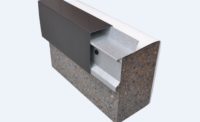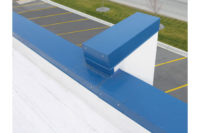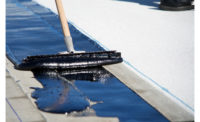What began as a short blog for Roofing Contractor magazine on technical tips for TPO membranes quickly took on a life of its own. The more single-ply experts we spoke with, the longer and more meaningful the list became. Even limiting the discussion to TPO and PVC membranes, the topic soon became worthy of a full-blown article.
The sources of these design and installation tips include some of the most respected names in the low-slope roofing industry. Together, they represent well over 100 years of combined single-ply roofing manufacturing, design and installation experience.
As always, the specific manufacturer’s roof design and installation instructions supersede any advice given here.
Before we begin, it should be mentioned that the current generation of TPO (thermoplastic polyolefin) and PVC (polyvinyl chloride) single-ply roofing systems have achieved an outstanding performance record in the low-slope roofing market. These single-ply membranes have been available and successfully performing in roofing applications for quite some time — in some cases, well over 20 years.
SPRI, the association representing sheet membrane and component suppliers to the commercial roofing industry, reports that in just the past five years alone, there have been more than 4 billion square feet of TPO membrane sold in North America, nearly the entirety of which have performed without issue.
However, like any other roofing system, single plies are vulnerable to the unintended consequences of poorly thought out roof design decisions and other incidental issues that have little or nothing to do with the TPO or PVC roof membranes themselves.
The fact is that the roofing industry has wrestled with some of these issues for decades. Other challenges relate to newer solar photovoltaic (PV) and vegetative roof installations over single-ply membranes. In fact, the industry continues to struggle for answers to some of the questions posed by these environmentally friendly and energy-saving building solutions.
Moisture Under Single-Ply Membranes
For our purposes, we will consider the problem of moisture entering the roofing system and condensing on the roof insulation or under the single-ply roof membrane. In reality, it is the responsibility of the architect or specifier to require the use of a vapor retarder and place it in the proper place within the roofing system. This decision will depend heavily on climate and building use.
There has been a lot of discussion lately about moisture condensing on the underside of light-colored single-ply membranes in cold climates. Of course, roofing contractors may also find moisture problems in dry climates like Phoenix, when unusually high moisture levels inside the conditioned building move up and into the roofing system and condense.
Condensation under white or light-colored roof membranes can be a problem with almost any mechanically attached single-ply membrane. Moisture can travel up through the joints in the insulation and hit the cold side of the roof membrane — or the membrane adhesive — and condense. Depending on the insulation used, this may result in “picture framing,” where rectangular ridges are visible outlining the pieces of insulation. The condensed moisture (water) may also move laterally through the roofing system, creating even greater problems for roofing contractors.
This phenomenon is nothing new in the roofing industry. Moisture has been condensing under single-ply roofing membranes since the early 1980s. Vapor moisture will condense on any cold surface, and lighter-colored membranes do not dissipate this condensed moisture as quickly as a dark-colored membrane.
It is the responsibility of the architect to properly design the roofing system to minimize moisture condensation, either through the use of a vapor retarder or through the use of two layers of insulation and staggering the joints to make it more difficult for moisture to reach the underside of the roof membrane. In fact, the National Roofing Contractors Association (NRCA) has been advocating this practice for more than a decade.
So it’s high time that roofing contractors and specifiers “sell” property owners on the benefits of two layers of insulation. It may be more expensive in the short term, but it is also more energy efficient and more effective in limiting moisture migration and condensation under the roof membrane.
Heat Aging of Single-Ply Membranes
Another important discussion going on within the roofing industry is the incidental high heat loading on white single-ply roofing membranes. This is a particular problem at roof/wall junctures, especially beneath high, west-facing walls in warm, sunny climates.
If a white TPO or PVC membrane is installed vertically up a wall or high curb, it may reflect down onto the horizontal portion of the roof membrane and create conditions that will accelerate the heat aging of the sheet.
Typically, the service temperature of a white TPO or PVC membrane is around 125 degrees Farentheit to 130°F. However, the temperature of the membrane below a highly reflective wall surface can reach 170°F or higher. Obviously, this is an unintended consequence of the designer not thinking about the ramifications of a high wall, curb or other highly reflective vertical surface.
The same principle holds true of white TPO and PVC membranes beneath reflective glass surfaces, curtain walls, painted white walls, shiny metals, or any other type of highly reflective surface. Of course, premature heat aging of TPO and PVC membranes is a function of time, temperature and UV exposure. So a white wall in Chicago will be much less of a problem than a similar configuration in Phoenix.
One solution to this potential problem is to specify a high-performance TPO roof membrane around perimeters or other areas exposed to high heat aging conditions. These new TPO membranes are formulated with proprietary stabilizers and UV absorbers specifically for solar roof installations, but they have other uses as well. Laboratory results conducted by roofing manufacturers show that these new membranes have achieved weathering performance far beyond current standards.
It is also important for roof consultants and contractors to understand that dark-colored TPO and PVC membranes may exhibit different welding characteristics than white membranes. Also, dark-colored membranes sometimes used for rooftop logos or other applications may be formulated for increased heat aging, while the light-colored membranes they are coupled with may not be. That’s why it’s important to understand the differences in thermoplastic membrane characteristics when using different color sheets on the same roof.
Roofing contractors and specifiers should also think twice before allowing the use of dark-colored materials (walkways, etc.) directly over white TPO and PVC membranes. A more logical choice may be a light gray walkway roll to limit heat aging of the membrane underneath.
Also, areas of poor drainage can create dark stains that can absorb heat and speed up the heat aging process of a roofing membrane. Dark-colored, thin-film photovoltaic (PV) systems may also contribute to accelerated heat aging of TPO and PVC. In this situation, the use of a high-performance TPO membrane designed for solar applications is a good option.
Unintended Issues With Solar Installations
We’re sure that almost every roofing contractor reading this article has seen long runs of cast iron pipe sitting on four-by-four wood blocking over a single-ply or bituminous roof membrane. Due to the expansion and contraction of dissimilar materials, these wooden supports will move over time and take the cast iron pipe with them.
The same thing can happen when long runs of ballasted solar racking are installed together on a single-ply roof membrane. Despite the overburden, these heavy rack systems will move over time and take the roofing membrane along with it.
In many cases roofing manufacturers and contractors are not designing these racks and may have no say in how long the runs will be. This is a simple case of thermodynamics and the mechanics of materials, but it can be a serious issue with solar racking systems. And currently, the roofing industry does not have a documented solution for it. The effect of roof-mounted solar systems on the fire resistance of roofing systems is another challenging issue that SPRI and the roofing industry at large are currently sorting out and need to address for code compliance.
Structural Lightweight Concrete Decks
Moisture emanating from newly poured structural lightweight concrete decks has been an age-old problem that is finally getting the attention it deserves. There is a perception in the roofing industry that all concrete decks are the same. The fact is that they are not.
When structural lightweight concrete decks are poured over a non-removable, non-venting substrate, the wet concrete will not dry out. And the use of a surface dryness test it is often not sufficient to measure the large amounts of moisture trapped inside these poured concrete decks. In fact, you may very well get a “false positive” that the deck is ready for roofing.
Because these decks are not vented from above or below, once the building is conditioned and cooler weather occurs, vapor drive upward into the roof system can cause large amounts of water to enter into the roofing system, often with catastrophic effects.
This problem has become a greater concern as more general contractors realize how much less expensive it is to leave a metal pan in place below the poured structural lightweight concrete deck. In the past, these metal forms were typically removed before roofing installation.
This problem has been slow to be addressed because structural lightweight concrete decks are used much less often than the slotted (venting) steel decks the roofing industry is so accustomed to seeing in new construction applications.
In warm, humid climates, most knowledgeable general contractors will ensure that the HVAC system is working even before the drywall is put up. This way, when the building is conditioned, the HVAC system handles the moisture generated during construction and dries the building out. But this will only work if the structural lightweight concrete deck can vent from the bottom side (i.e., the metal pans are removed).
One individual attempted to solve this problem by drilling holes into the metal pans every 6 inches. Unfortunately, this still did not allow adequate venting of the structural lightweight concrete deck, and it began to “rain” inside the building due to water coming through the holes drilled into the metal pans.
Fortunately, this problem has come to the attention of the Midwest Roofing Contractors Association (MRCA). The group’s T&R (Technical & Research) Bulletin 1/2011 “Structural Lightweight Concrete Roof Decks” covers this issue in detail and includes a “course of action” for roofing professionals who encounter these decks. The document is available for direct download from MRCA’s home page at www.mrca.org.
One month after releasing this document, MRCA came out with another T&R Advisory Bulletin on the “Noteworthy Limitations of Water Based Bonding Adhesives.” This document is also available from MRCA’s website and should help roofing professionals avoid blisters in fully adhered TPO and PVC single-ply roofing systems.
A SPRI task force is also preparing a paper on water-based adhesives, which should be available by the time you read this.
Water-based adhesives are environmentally friendly and versatile when used with single-ply membranes, but there are strict limitations to their use. The best advice we can give roofing contractors is to read the manufacturer’s instructions carefully before specifying or using water based adhesives.
The issues described above are some — but not all — of the unintended consequences when specifying TPO and PVC single-ply roof membranes. They can usually be avoided if common sense and good roofing practices are used.
On the other hand, there are issues — particularly with some solar roof installations — where the roofing industry does not yet have all the answers. But rest assured that industry organizations are hard at work to provide roofing contractors with the definitive answers they seek.
NRCA addresses the issue of roof moisture management in a variety of areas on its website. Here’s one link to get you started:
http://www.nrca.net/rp/technical/search/librarydetails.aspx?IDNumber=24829
SPRI also addresses this concern in the results of a field study called “The Effects of Roof Membrane Color on Moisture Accumulation in Low-slope Commercial Roofing Systems.” For more information, readers can download the paper directly from SPRI’s home page (www.spri.org).







